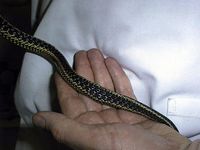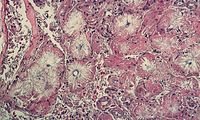Difference between revisions of "Snake Gout"
(Redirected page to Gout - Reptiles) |
|||
| (18 intermediate revisions by 5 users not shown) | |||
| Line 1: | Line 1: | ||
| − | + | {{unfinished}} | |
| + | [[Image:Bump2.jpg|200px|thumb|right|'''Biopsy of this swelling revealed renal gout''' - ©RVC and its licensors, Peer Zwart and Fredric Frye. All rights reserved]] | ||
| + | Gout is a metabolic disease where there is a precipitation of urate crystals in tissue. There are two types of gout in animals. | ||
| + | *In primary gout there is an overproduction of uric acid related to a innate metabolic problem. | ||
| + | *In secondary gout acquired disease interferes with the uric acid metabolism. Terrestrial reptiles are predisposed to secondary gout since nitrogenous waste is excreted as uric acid. | ||
| + | |||
| + | In snakes kidney disease often leads to the development of the [[Visceral gout|visceral form of gout]]. | ||
| + | |||
| + | '''For more information on excretion, see''' [[Lizard and Snake Excretion]]. | ||
| + | ==Examination== | ||
| + | History may show poor husbandry including limited access to water. Snakes often present as anorexic and lethargic. Often if kidney disease is involved there is a palpable lump in the caudal third. | ||
| + | |||
| + | '''For more information on good husbandry practices, see''' [[:Category: Snake Husbandry| Snake Husbandry]]. | ||
| + | [[Image:Necropsy_copy.jpg|200px|thumb|right|'''Tophi in renal tissue''' - ©RVC and its licensors, Peer Zwart and Fredric Frye. All rights reserved]] | ||
| + | ==Diagnosis== | ||
| + | The diagnosis of gout may be suspected on history and physical examination. Biochemistry may indicate a hyperuricaemia. Sometimes radiography is useful if calcium is deposited with the urate crystals. Biopsy of any lumps may be useful. A definite diagnosis is the demonstration of tophi in diseased tissue. | ||
| + | |||
| + | '''For more information on physical examinations, see''' [[Snake Physical Examination]]. | ||
| + | |||
| + | '''For more information on biopsy collection, see''' [[Lizard and Snake Specimen Collection and Evaluation|Specimen Collection and Evaluation]]. | ||
| + | [[Image:Renal_gout_python_regius.jpg|200px|thumb|right|'''Tophi in diseased tissue''' - ©RVC and its licensors, Peer Zwart and Fredric Frye. All rights reserved]] | ||
| + | ==Therapy== | ||
| + | Supportive treatment especially aimed at rehydration may be useful but gout carries a poor prognosis. Previously allopurinol (a xanthine oxidase inhibitor that decreases formation of uric acid) has been recommended as a treatment of hyperuricaemia in reptiles and birds but in fact appears to be of little use. Other drugs such as uricases (enzymes involved in the degradation of uric acid to allantoin) may be more useful. | ||
| + | ==Prevention== | ||
| + | Any bouts of dehydration will predispose to the development of gout so good husbandry is important in prevention. Veterinarians should ensure adequate hydration of reptiles prior to any drug therapy especially the use of nephrotoxic drugs. | ||
| + | |||
| + | [[Category:Snake_Diseases]] | ||
Revision as of 17:20, 6 May 2010
| This article is still under construction. |
Gout is a metabolic disease where there is a precipitation of urate crystals in tissue. There are two types of gout in animals.
- In primary gout there is an overproduction of uric acid related to a innate metabolic problem.
- In secondary gout acquired disease interferes with the uric acid metabolism. Terrestrial reptiles are predisposed to secondary gout since nitrogenous waste is excreted as uric acid.
In snakes kidney disease often leads to the development of the visceral form of gout.
For more information on excretion, see Lizard and Snake Excretion.
Examination
History may show poor husbandry including limited access to water. Snakes often present as anorexic and lethargic. Often if kidney disease is involved there is a palpable lump in the caudal third.
For more information on good husbandry practices, see Snake Husbandry.
Diagnosis
The diagnosis of gout may be suspected on history and physical examination. Biochemistry may indicate a hyperuricaemia. Sometimes radiography is useful if calcium is deposited with the urate crystals. Biopsy of any lumps may be useful. A definite diagnosis is the demonstration of tophi in diseased tissue.
For more information on physical examinations, see Snake Physical Examination.
For more information on biopsy collection, see Specimen Collection and Evaluation.
Therapy
Supportive treatment especially aimed at rehydration may be useful but gout carries a poor prognosis. Previously allopurinol (a xanthine oxidase inhibitor that decreases formation of uric acid) has been recommended as a treatment of hyperuricaemia in reptiles and birds but in fact appears to be of little use. Other drugs such as uricases (enzymes involved in the degradation of uric acid to allantoin) may be more useful.
Prevention
Any bouts of dehydration will predispose to the development of gout so good husbandry is important in prevention. Veterinarians should ensure adequate hydration of reptiles prior to any drug therapy especially the use of nephrotoxic drugs.


